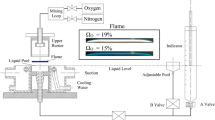Abstract
Highly divided C can be formed by heat treatment of hydrocarbons in absence of O (thermal decomposition) or in its presence (flames). This variety of C, named soot or carbon black, has a considerable polluting effect. Moreover, considering the increasing cost of energy sources, energy loss under the form of unburnt species has to be reduced. To decrease or to suppress soot formation, it is often necessary to know the mechanism of formation and, in particular, the phenomena involved in the nucleation step.
The mechanism of soot formation in flames is basically identical in premixed flames and in diffusion flames. However, as the different chemical stages are well separated, from a spatial point of view, in premixed flames, most investigations deal with this type of flame.
In the oxidation zone of the flame (blue zone), a part of the hydrocarbon is burnt out while another part undergoes complex reactions leading to polyacetylenes and later to polycyclic hydrocarbons with lateral chains. In the same region, ions are formed by chemiionization.
In the zone of formation of C particles (yellow zone), polycyclic hydrocarbons are dehydrogenated and give polyaromatic hydrocarbons; their partial pressure increases until they reach a supersaturation high enough to induce nucleation of liquid microdroplets. The microdroplets are formed by homogeneous nucleation as well, probably, as the nucleation on the positive ions formed in the oxidation zone of the flame; they are converted by growth, association and chemical transformation into solid soot particles.
In thermal systems, the mechanisms involved are identical except that nucleation on ions may be disregarded.
In both systems, nucleation of microdroplets is a fast and discontinuous phenomenon.
Such an understanding in C particle formation might be efficiently used to reduce noticeably atmospheric pollution and energy loss by soot formation.
Similar content being viewed by others
References
Donnet, J. B.: 1965, ‘Les Carbones’, Masson Ed. Paris, tome 11, 712.
Palmer, H. B. and Cullis, C. F.: 1965, in P. L. Walker Jr. (ed.), Chemistry and Physics of Carbon, Vol. 1, Dekker, New-York, p.p. 265.
Feugier, A.: 1969, Rev. Inst. Fr. Petr. XXIV II, 1374.
Gaydon, A. G. and Wolfhard, H. G.: 1970, Flames, 3rd edition, Chapman and Hall Ed., London.
Homann, K. H.: 1967, Combust Flame 11, 265.
Bonne, U., Homann, K. H., and Wagner, H. G. g.: 1965, Tenth Symp. (Intern.) on Combust., p. 503.
Palmer, H. B., Voet, A., and Lahaye, J.: 1968, Carbon 6, 65.
Chakraborty, B. B. and Long, R.: 1968, Combust. Flame 12 (3), 226.
Feugier, A.: 1970, Rev. Gin. Therm. 105, 1045.
Calcote, H. F., Kurzius, S. C., and Miller, W. J.: 1965, Tenth. Symp. (Intern.) on Combust., p. 605.
Peeters, J., Vinckier, C., and Van Tiggelen, A.: 1969, Oxidation Combust. Rev. 4, 93.
Delfau, J. L.: 1972, Réalisation d'un spectromètre de masse pour létude des ions dans les flammes. Application aux flammes de prémé1ange méthane-oxygène dilué par l'azote. Thèse de 3e cycle, Université d'Orléans, 12 Octobre.
Lahaye, J. and Prado, G.: 1974, Mechanisms of Carbon Black Formation, Review to be published in P. L. Walker Jr. (ed.), ‘Chemistry and Physics of Carbon’ M. Dekker, New-York.
Place, E. R. and Weinberg, F. J.: 1967, Eleventh Symp. (Intern.) on Combust., p. 245.
Wersborg, B. L., Howard, J. B., and Williams, G. C.: 1973, Fourteenth Symp. (Intern.) on Combust., p. 929.
Wersborg, B. L.: 1972, Doctoral Thesis Digest, Dept. of Chemical Engineering, Massachusetts Inst. of Technol., Aug. 1972.
Volmer, M. and Weber, A.: 1926, Z. Physik. Chem. Leipzig 119, 277.
Becker, R. and Doering, W.: 1935, Ann. Phys. 24, 719.
Zel'dovitch, J. B.: 1942, J. Exp. Theoret. Phys. 12, 525; 1943, Act. Phys. Chem. SSSR, 18, 1.
Prado, G.: 1972, Doctorat ès Sciences (Centre Universitaire du Haut-Rhin et Université Louis-Pasteur de Strasbourg).
Prado, G. and Lahaye, J.: 1972, C.R. Acad. Sci. Paris 274, 569; 1880.
Lahaye, J., Prado, G., and Donnet, J. B.: 1971, Tenth Biennial Conference on Carbon, Lehigh, University, Summary of papers, p. 102, printed by D.C.I.C.
Lahaye, J. and Prado, G.: 1973, Eleventh Biennial Conference on Carbon, Extended Abstracts, p. 41.
Lahaye, J., Prado, G., and Donnet, J. B.: 1974, Carbon 12, 27.
Lahaye, J. and Prado, G.: 1974, Unpublished results.
Ulrich, G. D.: 1971, Comb. Sci. Techn. 4, 47.
Medalia, A. I.: 1967, J. Colloid Sci. 24, 393.
Sutherland, D. N.: 1966, J. Colloid Interface Sci. 22, 300; 1967, 25, 373.
Ravey, J. C.: 1973, Thèse de Doctorat ès Sciences Physiques (Université de Nancy I), 1973.
Tsygankova, E. I., Zuev, V. P., and Evreinova, M. D.: 1970, Gazov. Prom. 15, (2), 40.
Kargin, V. A., Berestneva, Z. Ya., Safronov, N. Ya., and Zhilkina, V. I.: 1967, Kolloid. Zh. 29 (3), 342.
Tesner, P. A.: 1958, 7th Symp. on Combust., London and Oxford, 546.
Abadzhev, S. S., Tesner, P. A., and Shevchah, U. V.: 1969, Gaz. Prom. 14 (10), 36.
Parker, W. G. and Wolfhard, H. G.: 1950, J. Chem. Soc. 2038.
Sweitzer, C. W. and Heller, G. L.: 1956, Rubber World 134, 855.
Author information
Authors and Affiliations
Rights and permissions
About this article
Cite this article
Lahaye, J., Prado, G. Formation of carbon particles from a gas phase: Nucleation phenomenon. Water, Air, and Soil Pollution 3, 473–481 (1974). https://doi.org/10.1007/BF00341000
Issue Date:
DOI: https://doi.org/10.1007/BF00341000




